Multi-Scale Analysis of the Damage Evolution of Coal Gangue Coarse Aggregate Concrete after Freeze–Thaw Cycle Based on CT Technology
Abstract
1. Introduction
2. Materials and Methods
2.1. Raw Materials
2.1.1. Coal Gangue Coarse Aggregate
2.1.2. Other Materials
2.2. Specimen Preparation
2.3. Experiment Methods
2.3.1. Freeze–Thaw Cycles Test
2.3.2. X-ray CT Scanning Test
3. Results and Discussion
3.1. Analysis of the Relative Dynamic Modulus of Elasticity and Mass Change
3.2. Relationship between Compressive Strength and Cycle Times
3.3. Analysis of Meso-Characteristics of Coal Gangue Concrete
3.3.1. Two-Dimensional Pore Structure of Coal Gangue Concrete under Freeze–Thaw Cycle
3.3.2. Three-Dimensional Pore Structure of Coal Gangue Concrete in a Freeze–Thaw Cycle
3.4. Evolution Law of the Freeze–Thaw Damage of Coal Gangue Concrete
3.4.1. Definition of the Macro–Meso Freeze–Thaw Damage Variable
3.4.2. Prediction of Deterioration Law of Elastic Modulus Based on Meso-Damage
4. Conclusions
- With an increase in the replacement rate of coal gangue aggregate in freeze–thaw environments, the frost resistance of concrete gradually diminishes. In particular, when the coal gangue replacement rate exceeds 60%, the performance of concrete deteriorates sharply during freeze–thaw cycles. Therefore, under cold and humid climate conditions, choosing coal gangue as a replacement for gravel in concrete may significantly shorten the service life of concrete. Hence, in cold regions, the replacement rate of coal gangue aggregate should not exceed 30% when substituting natural aggregates.
- Conventional methods, if the initial defects in concrete and the impacts of meso-structural changes on damage expansion have been neglected, exhibit noticeable disparities in the evolution curves of macroscopic and mesoscopic damage variables. The macroscopic and mesoscopic freeze–thaw damage variables proposed in this study, accounting for pore size and shape, facilitate the cohesive identification of damage in the same material across different scales. This approach introduces a novel quantitative method for the multi-scale investigation of damage characteristics in CGC subjected to F-Ts.
- The prediction model for the elastic modulus of CGC under various F-Ts provides a means to assess CGC damage by systematically examining the diverse influences of pore size and pore structure. It can quantitatively describe the evolution of microstructure and macroscopic mechanical response.
5. Futures and Perspectives
Author Contributions
Funding
Institutional Review Board Statement
Informed Consent Statement
Data Availability Statement
Conflicts of Interest
Abbreviations
| Mloss | rate of mass loss |
| Er | relative dynamic elastic modulus |
| σc | compressive strength |
| D | fractal dimension |
| Nk | number of boxes |
| δk | size of the box |
| Sn | the traditional meso freeze–thaw damage variables |
| Sn′ | the traditional macro freeze–thaw damage variables |
| A | the nominal bearing volume of concrete |
| Ã | the internal failure zone volume of concrete |
| E0 | the elastic modulus of saturated unfreeze–thawed CGC |
| En | the elastic modulus of CGC after undergoing various F-Ts |
| STn | the modified meso freeze–thaw damage variable |
| Dn | the pore fractal dimension of concrete under different F-Ts times |
| η0 | the porosity of concrete after undergoing 0 F-T |
| D0 | the pore fractal dimension of concrete after undergoing 0 F-T |
| SEn | the modified macro freeze–thaw damage variable |
| En′ | the predicted value of elastic modulus |
References
- National Bureau of Statistics of China. Statistical Bulletin of National Economic and Social Development of the People’s Republic of China in 2021; National Bureau of Statistics of China: Beijing, China, 2022.
- Li, Y.F.; Liu, S.H.; Guan, X.M. Multitechnique investigation of concrete with coal gangue. Constr. Build. Mater. 2021, 301, 124114. [Google Scholar] [CrossRef]
- Chilikwazi, B.; Onyari, J.M.; Wanjohi, J.M. Determination of heavy metals concentrations in coal and coal gangue obtained from a mine, in Zambia. Int. J. Environ. Sci. Technol. 2023, 20, 2053–2062. [Google Scholar] [CrossRef]
- China National Coal Association. Annual Report on Coal Industry in China (2022); China National Coal Association: Beijing, China, 2023.
- Moghadam, M.J.; Ajalloeian, R.; Hajiannia, A. Preparation and application of alkali-activated materials based on waste glass and coal gangue: A review. Constr. Build. Mater. 2019, 221, 84–98. [Google Scholar] [CrossRef]
- Qureshi, A.A.; Kazi, T.G.; Baig, J.A.; Arain, M.B.; Afridi, H.I. Exposure of heavy metals in coal gangue soil, in and outside the mining area using BCR conventional and vortex assisted and single step extraction methods. Impact on orchard grass. Chemosphere 2020, 255, 126960. [Google Scholar] [CrossRef]
- Golewski, G.L. The Effect of the Addition of Coal Fly Ash (CFA) on the Control of Water Movement within the Structure of the Concrete. Materials 2023, 16, 5218. [Google Scholar] [CrossRef]
- Golewski, G.L. Fracture Performance of Cementitious Composites Based on Quaternary Blended Cements. Materials 2022, 15, 6023. [Google Scholar] [CrossRef]
- Zhang, M.; Lv, H.; Zhou, S.; Wu, Y.; Zheng, X.; Yan, Q. Study on the Frost Resistance of Composite Limestone Powder Concrete against Coupling Effects of Sulfate Freeze-Thaw. Buildings 2023, 13, 2776. [Google Scholar] [CrossRef]
- Hashemmoniri, S.; Fatemi, A. Optimization of lightweight foamed concrete using fly ash based on mechanical properties. Innov. Infrastruct. Solut. 2023, 8, 59. [Google Scholar] [CrossRef]
- Onaizi, A.M.; Huseien, G.F.; Lim, N.H.A.S.; Amran, M.; Samadi, M. Effect of nanomaterials inclusion on sustainability of cement-based concretes: A comprehensive review. Constr. Build. Mater. 2021, 306, 124850. [Google Scholar] [CrossRef]
- Moein, M.M.; Rahmati, K.; Saradar, A.; Moon, J.; Karakouzian, M. A Critical Review Examining the Characteristics of Modified Concretes with Different Nanomaterials. Materials 2024, 17, 409. [Google Scholar] [CrossRef]
- Bautista-Gutierrez, K.P.; Herrera-May, A.L.; Santamaría-López, J.M.; Honorato-Moreno, A.; Zamora-Castro, S.A. Recent Progress in Nanomaterials for Modern Concrete Infrastructure: Advantages and Challenges. Materials 2019, 12, 3548. [Google Scholar] [CrossRef]
- Yoo, D.-Y.; Oh, T.; Banthia, N. Nanomaterials in ultra-high-performance concrete (UHPC)—A review. Cem. Concr. Compos. 2022, 134, 104730. [Google Scholar] [CrossRef]
- Gao, S.; Zhang, S.; Guo, L. Application of Coal Gangue as a Coarse Aggregate in Green Concrete Production: A Review. Materials 2021, 14, 6803. [Google Scholar] [CrossRef] [PubMed]
- Onuaguluchi, O.; Eren, Ö. Reusing copper tailings in concrete: Corrosion performance and socioeconomic implications for the Lefke-Xeros area of Cyprus. J. Clean. Prod. 2016, 112, 420–429. [Google Scholar] [CrossRef]
- Ramalingam, M.; Sivamani, J.; Narayanan, K. Performance studies on recycled aggregate concrete with treated recycled aggregates. Waste Dispos. Sustain. Energy 2023, 5, 451–459. [Google Scholar] [CrossRef]
- Nepomuceno, M.C.S.; Isidoro, R.A.S.; Catarino, J.P.G. Mechanical performance evaluation of concrete made with recycled ceramic coarse aggregates from industrial brick waste. Constr. Build. Mater. 2018, 165, 284–294. [Google Scholar] [CrossRef]
- Alqarni, A.S.; Albidah, A.; Abbas, H.; Almusallam, T.; Al-Salloum, Y. Concrete Performance Produced Using Recycled Construction and By-Product Industrial Waste Coarse Aggregates. Materials 2022, 15, 8985. [Google Scholar] [CrossRef]
- Wang, Q.; Li, Z.; Zhang, Y.; Zhang, H.; Zhou, M.; Fang, Y. Influence of coarse coal gangue aggregates on elastic modulus and drying shrinkage behaviour of concrete. J. Build. Eng. 2020, 32, 101748. [Google Scholar] [CrossRef]
- Wen, B.; Huang, D.; Zhang, L.; Song, Q.; Gao, G.; Huo, D. Study on mechanical properties and size effect of coal gangue concrete at mesoscale. Constr. Build. Mater. 2022, 360, 129551. [Google Scholar] [CrossRef]
- Li, J.Y.; Wang, J.M. Comprehensive utilization and environmental risks of coal gangue: A review. J. Clean. Prod. 2019, 239, 117946. [Google Scholar] [CrossRef]
- Zhang, N.; Zhao, Z.; Zheng, C. Compression behavior of GFRP–coal gangue concrete–steel tubular columns. Int. J. Press. 2022, 197, 104650. [Google Scholar] [CrossRef]
- Zhang, Y.; Xu, Q.; Wang, Q.; Zhou, M.; Liu, H.; Guo, H. Axial compressive behavior of circular concrete-filled steel tube stub columns prepared with spontaneous-combustion coal gangue aggregate. J. Build. Eng. 2022, 48, 103987. [Google Scholar] [CrossRef]
- Qiu, J.S.; Zhou, Y.X.; Vatin, N.I.; Guan, X.; Sultanov, S.; Khemarak, K. Damage constitutive model of coal gangue concrete under freeze-thaw cycles. Constr. Build. Mater. 2020, 264, 120720. [Google Scholar] [CrossRef]
- Freire-Lista, D.M.; Fort, R.; Varas-Muriel, M.J. Freeze-thaw fracturing in building granites. Cold Reg. Sci. Technol. 2015, 113, 40–51. [Google Scholar] [CrossRef]
- Nili, M.; Azarioon, A.; Hosseinian, S.M. Novel Internal-Deterioration Model of Concrete Exposed to Freeze-Thaw Cycles. J. Mater. Civ. Eng. 2017, 29, 04017132. [Google Scholar] [CrossRef]
- Rooney, E.C.; Bailey, V.L.; Patel, K.F.; Possinger, A.R.; Gallo, A.C.; Bergmann, M.; SanClements, M.; Lybrand, R.A. The Impact of Freeze-Thaw History on Soil Carbon Response to Experimental Freeze-Thaw Cycles. J. Geophys. Res. Biogeosci. 2022, 127, e2022JG006889. [Google Scholar] [CrossRef]
- Orakoglu, M.E.; Liu, J.K.; Niu, F.J. Dynamic behavior of fiber-reinforced soil under freeze-thaw cycles. Soil Dyn. Earthq. Eng. 2017, 101, 269–284. [Google Scholar] [CrossRef]
- Cheng, X.; Tian, W.; Gao, J.F.; Guo, J.; Wang, X.H. Grey entropy analysis of strength and void structure of carbon nanotubes concrete under the coupling of sulfate attack and freeze-thaw cycles. Constr. Build. Mater. 2022, 358, 129462. [Google Scholar] [CrossRef]
- JGJ 52-2006; Standard for Technical Requirements and Test Method of Sand and Crushed Stone (or Gravel) for Ordinary Concrete. China Architecture & Building Press: Beijing, China, 2006. (In Chinese)
- GB/T 14685-2011; Pebble and Crushed Stone for Construction. Standards Press of China: Beijing, China, 2011. (In Chinese)
- Cheng, X.; Tian, W.; Gao, J.F.; Gao, Y. Performance evaluation and lifetime prediction of steel slag coarse aggregate concrete under sulfate attack. Constr. Build. Mater. 2022, 344, 128203. [Google Scholar] [CrossRef]
- Zhao, H.; Wang, S.; Wang, R.; Shen, L.; Wang, Q. Utilization of raw coal gangue as coarse aggregates in pavement concrete. Constr. Build. Mater. 2023, 378, 131062. [Google Scholar] [CrossRef]
- Alaskar, A.; Alshannag, M.; Higazey, M. Mechanical properties and durability of high-performance concrete internally cured using lightweight aggregates. Constr. Build. Mater. 2021, 288, 122998. [Google Scholar] [CrossRef]
- JGJ 55-2011; Specification for Mix Proportion Design of Ordinary Concrete. China Architecture & Building Press: Beijing, China, 2011. (In Chinese)
- GB/T 50081-2019; Standard for Test Methods of Concrete Physical and Mechanical Properties. China Architecture & Building Press: Beijing, China, 2019. (In Chinese)
- GB/T 50082-2009; Standard for Test Methods of Long-Term Performance and Durability of Ordinary Concrete. China Architecture & Building Press: Beijing, China, 2009. (In Chinese)
- Wang, Y.; Xia, J.; Li, P.; Yu, L.; Yang, H.; Chen, Y. Experimental Study and Analytical Modeling on Properties of Freeze-Thaw Durability of Coal Gangue Pervious Concrete. Materials 2023, 16, 7104. [Google Scholar] [CrossRef] [PubMed]
- Tian, W.; Han, N. Evaluation of Meso-damage Processes in Concrete by X-Ray CT Scanning Techniques Under Real-Time Uniaxial Compression Testing. J. Nondestr. Eval. 2019, 38, 44. [Google Scholar] [CrossRef]
- D’Altri, A.M.; Sarhosis, V.; Milani, G.; Rots, J.; Cattari, S.; Lagomarsino, S.; Sacco, E.; Tralli, A.; Castellazzi, G.; de Miranda, S. Modeling Strategies for the Computational Analysis of Unreinforced Masonry Structures: Review and Classification. Arch. Comput. Methods Eng. 2020, 27, 1153–1185. [Google Scholar] [CrossRef]
- Hackney, C.R.; Darby, S.E.; Parsons, D.R.; Leyland, J.; Best, J.L.; Aalto, R.; Nicholas, A.P.; Houseago, R.C. River bank instability from unsustainable sand mining in the lower Mekong River. Nat. Sustain. 2020, 3, 217–225. [Google Scholar] [CrossRef]
- Mangalathu, S.; Hwang, S.H.; Jeon, J.S. Failure mode and effects analysis of RC members based on machine-learning-based SHapley Additive exPlanations (SHAP) approach. Eng. Struct. 2020, 219, 110927. [Google Scholar] [CrossRef]
- Thai, H.T. Machine learning for structural engineering: A state-of-the-art review. Structures 2022, 38, 448–491. [Google Scholar] [CrossRef]
- Thilakarathna, P.S.M.; Baduge, K.S.K.; Mendis, P.; Vimonsatit, V.; Lee, H. Mesoscale modelling of concrete—A review of geometry generation, placing algorithms, constitutive relations and applications. Eng. Fract. Mech. 2020, 231, 106974. [Google Scholar] [CrossRef]
- Choi, J.H.; Edwards, P.; Ko, K.; Kim, Y.S. Definition and classification of fault damage zones: A review and a new methodological approach. Earth-Sci. Rev. 2016, 152, 70–87. [Google Scholar] [CrossRef]
- Farhat, F.; Shen, W.Q.; Xie, S.Y.; Shao, J.F.; Pourpak, H.; Su, K. A three-scale micro-mechanical model for elastic-plastic damage modeling of shale rocks. Acta Geotech. 2020, 15, 3525–3543. [Google Scholar] [CrossRef]
- Gallyamov, E.R.; Ramos, A.I.C.; Corrado, M.; Rezakhani, R.; Molinari, J.F. Multi-scale modelling of concrete structures affected by alkali-silica reaction: Coupling the mesoscopic damage evolution and the macroscopic concrete deterioration. Int. J. Solids Struct. 2020, 207, 262–278. [Google Scholar] [CrossRef]
- Tauber, J.; van der Gucht, J.; Dussi, S. Stretchy and disordered: Toward understanding fracture in soft network materials via mesoscopic computer simulations. J. Chem. Phys. 2022, 156, 160901. [Google Scholar] [CrossRef] [PubMed]
- Tian, W.; Cheng, X.; Liu, Q.; Yu, C.; Gao, F.F.; Chi, Y.Y. Meso-structure segmentation of concrete CT image based on mask and regional convolution neural network. Mater. Des. 2021, 208, 109919. [Google Scholar] [CrossRef]
- Xu, J.; Ren, J.; Wang, Z.; Wang, S.; Yuan, J. Strength behaviors and meso-structural characters of loess after freeze-thaw. Cold. Reg. Sci. Technol. 2018, 148, 104–120. [Google Scholar] [CrossRef]
- Jin, S.; Zheng, G.; Yu, J. A micro freeze-thaw damage model of concrete with fractal dimension. Constr. Build. Mater. 2020, 257, 119434. [Google Scholar] [CrossRef]
- Zhang, X.; Jin, J.; Liu, X.; Wang, Y.; Li, Y. Study on the Influence of Saturation on Freeze-Thaw Damage Characteristics of Sandstone. Materials 2023, 16, 2309. [Google Scholar] [CrossRef] [PubMed]

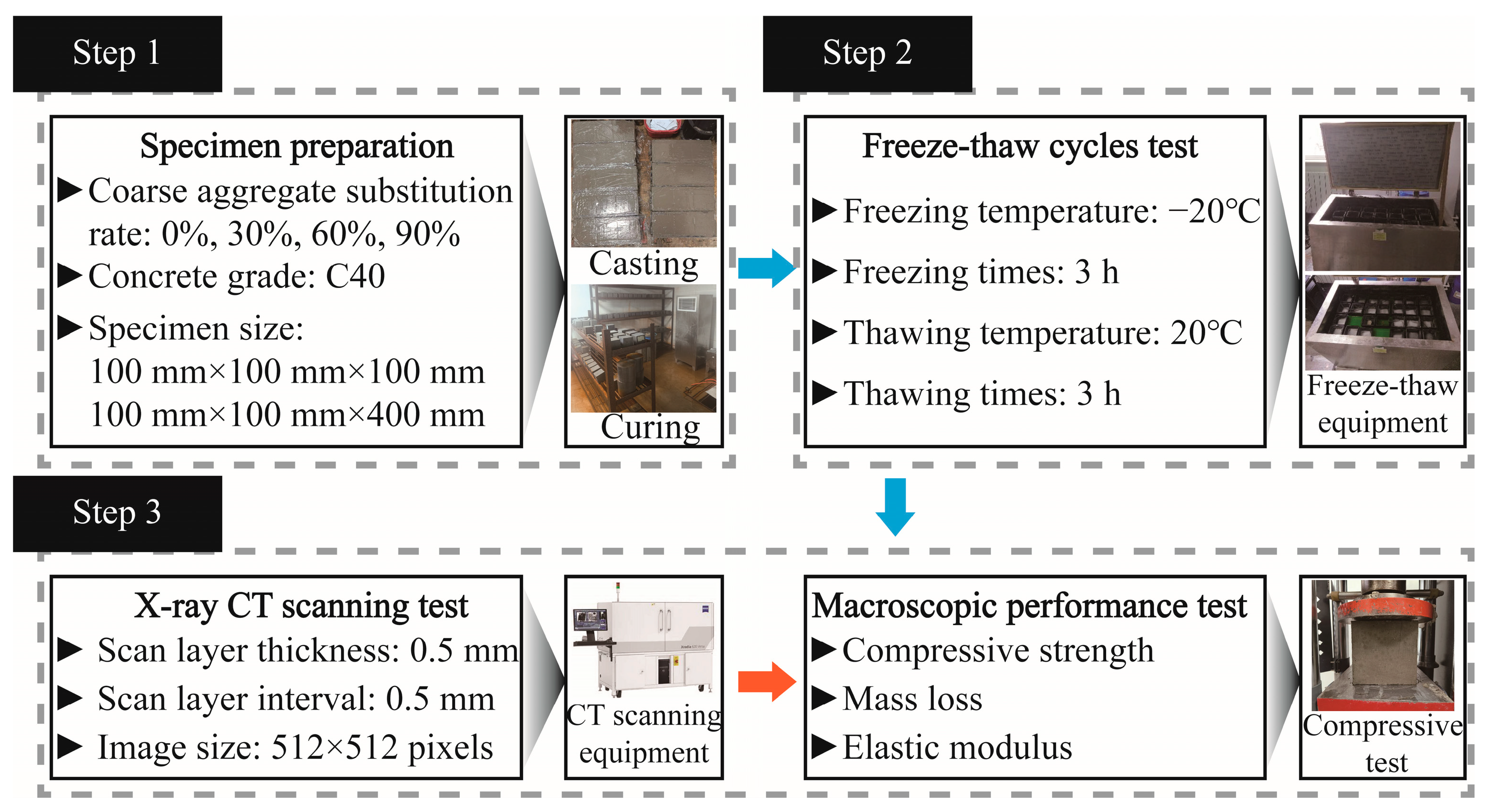
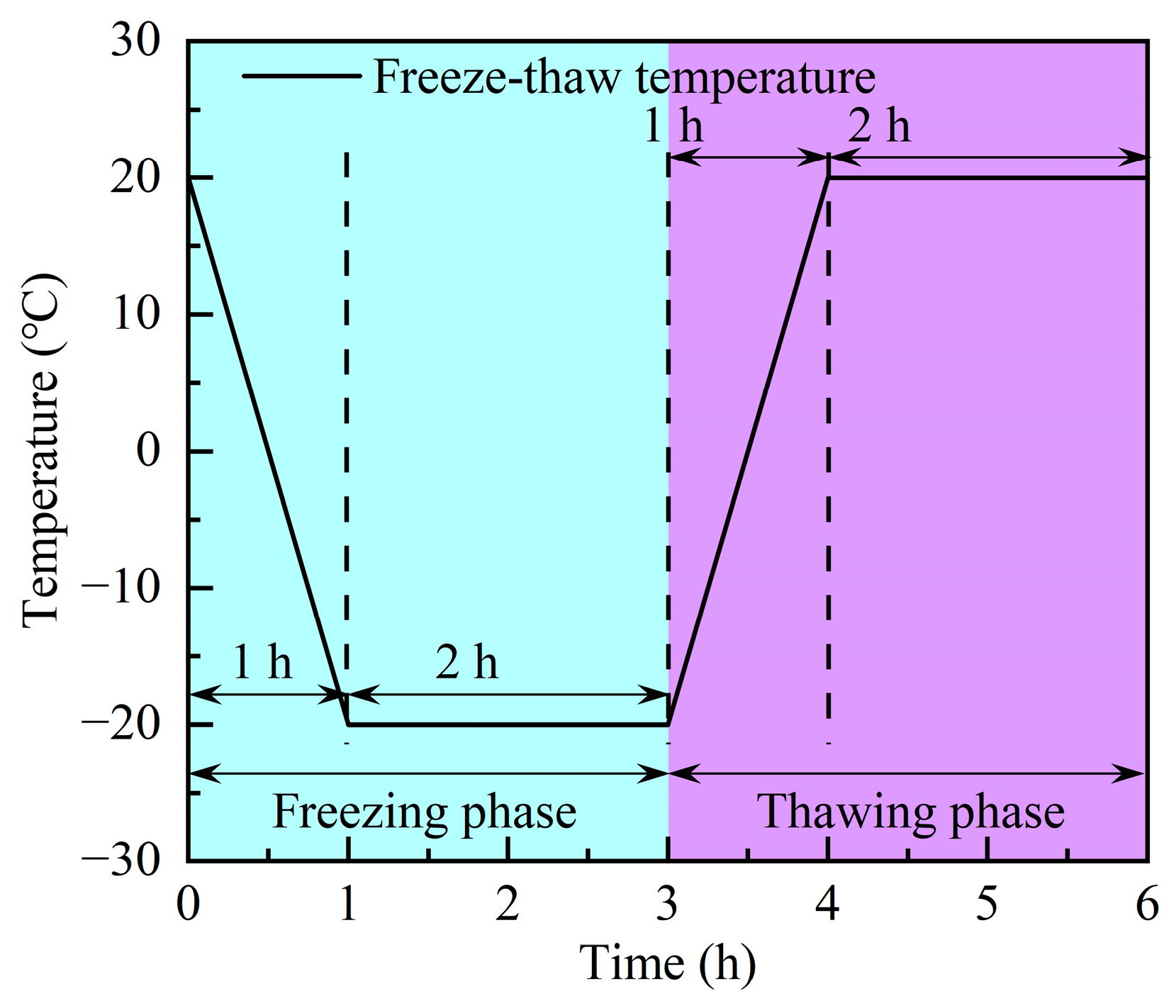
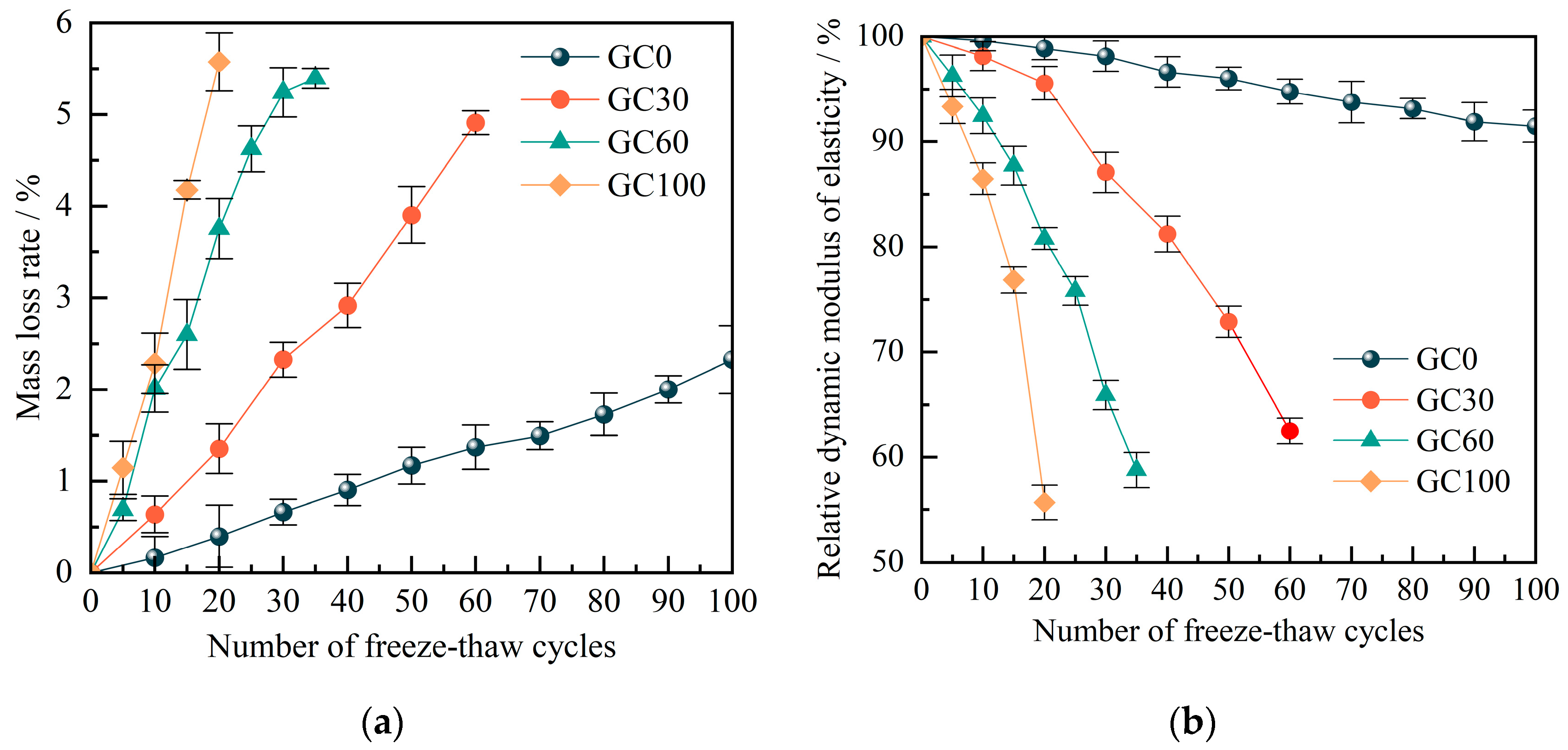

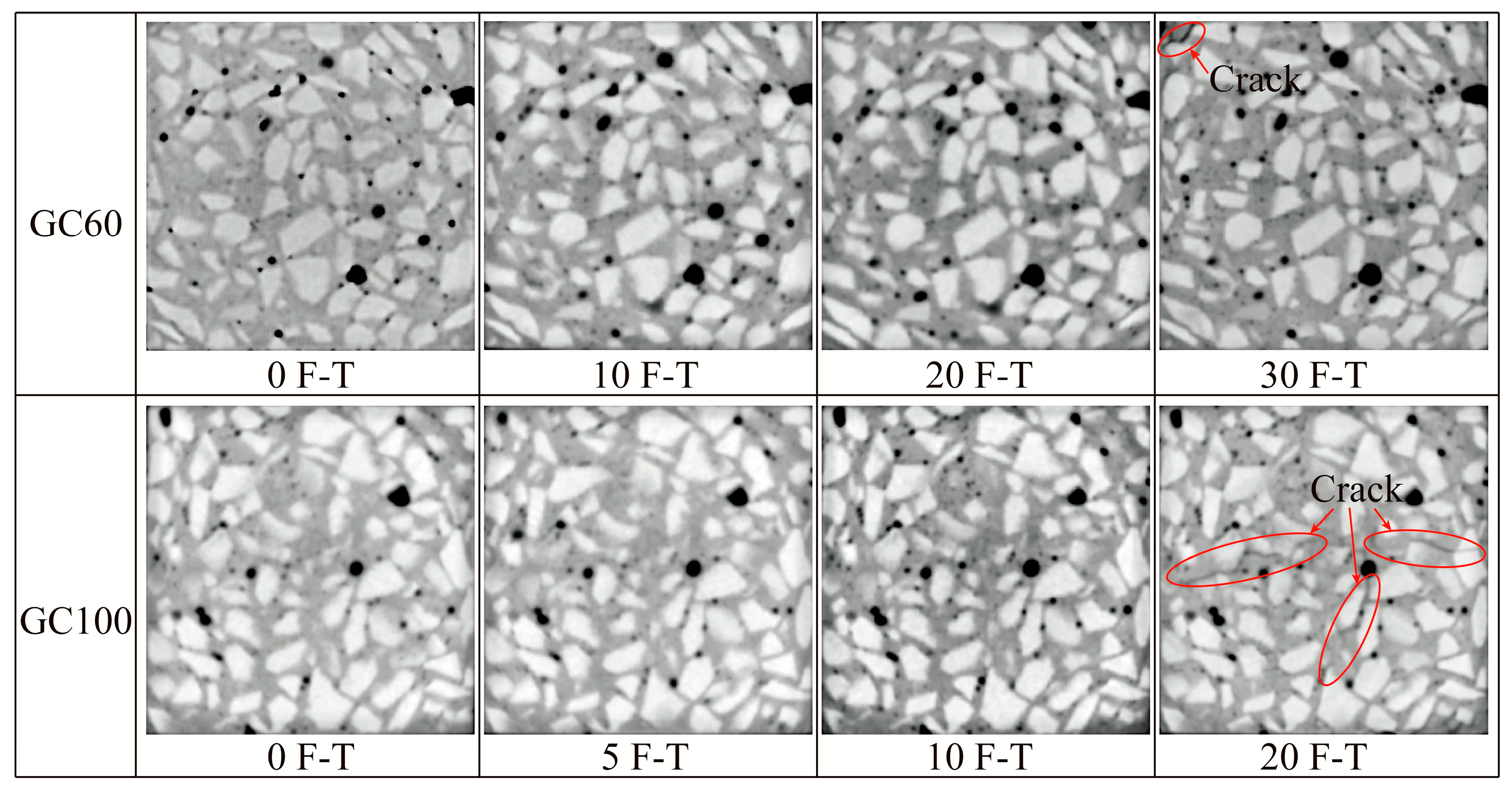

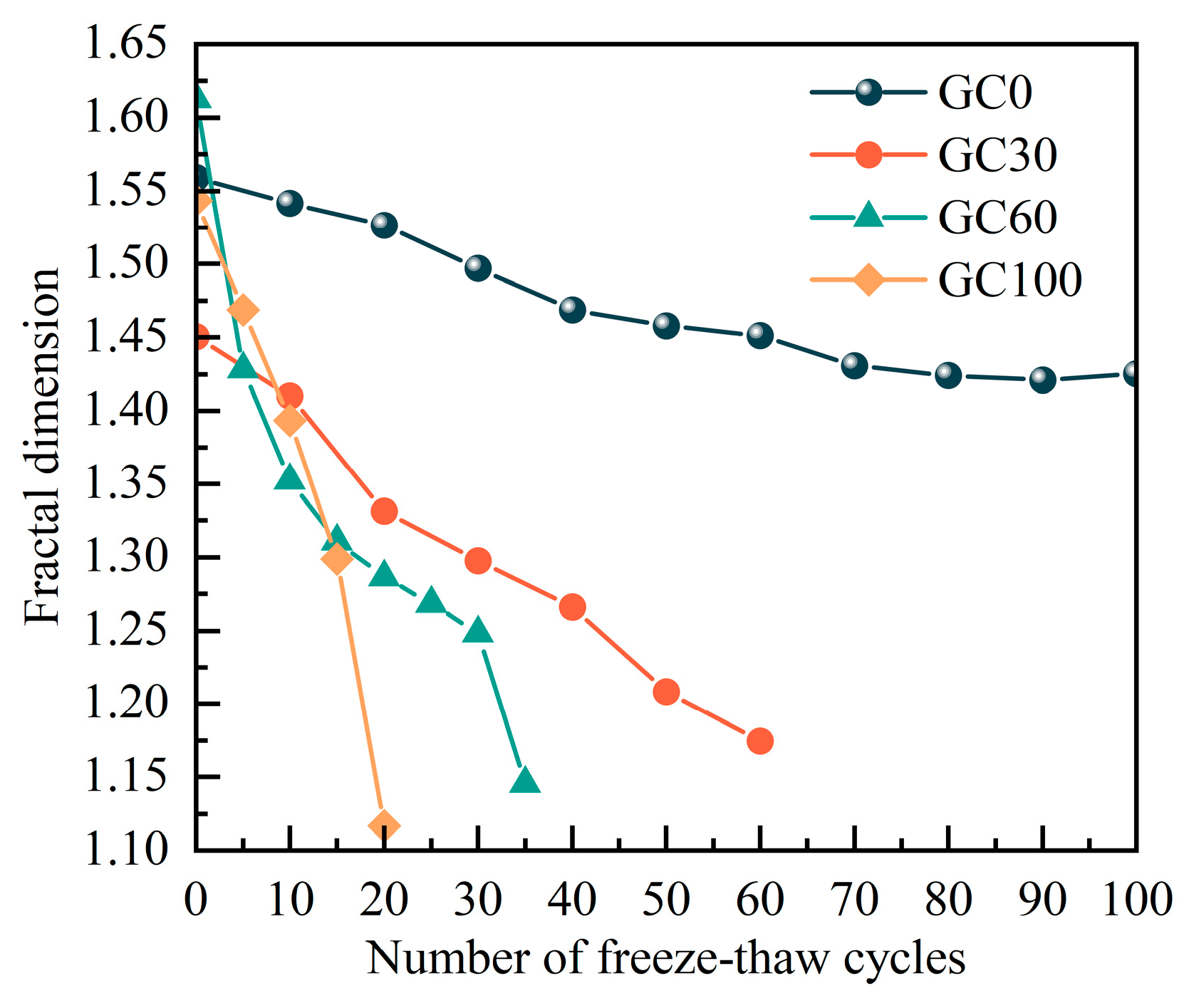

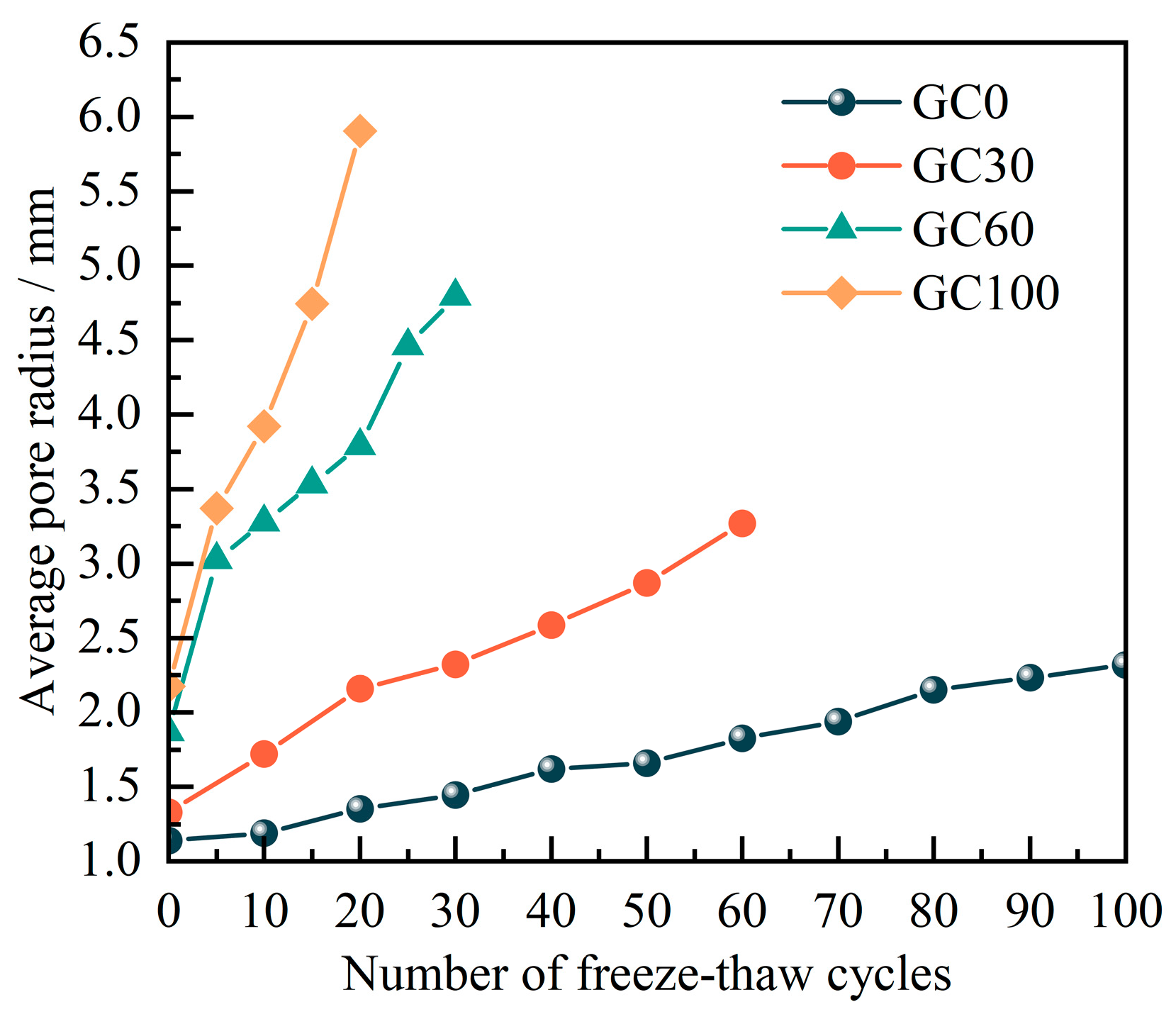
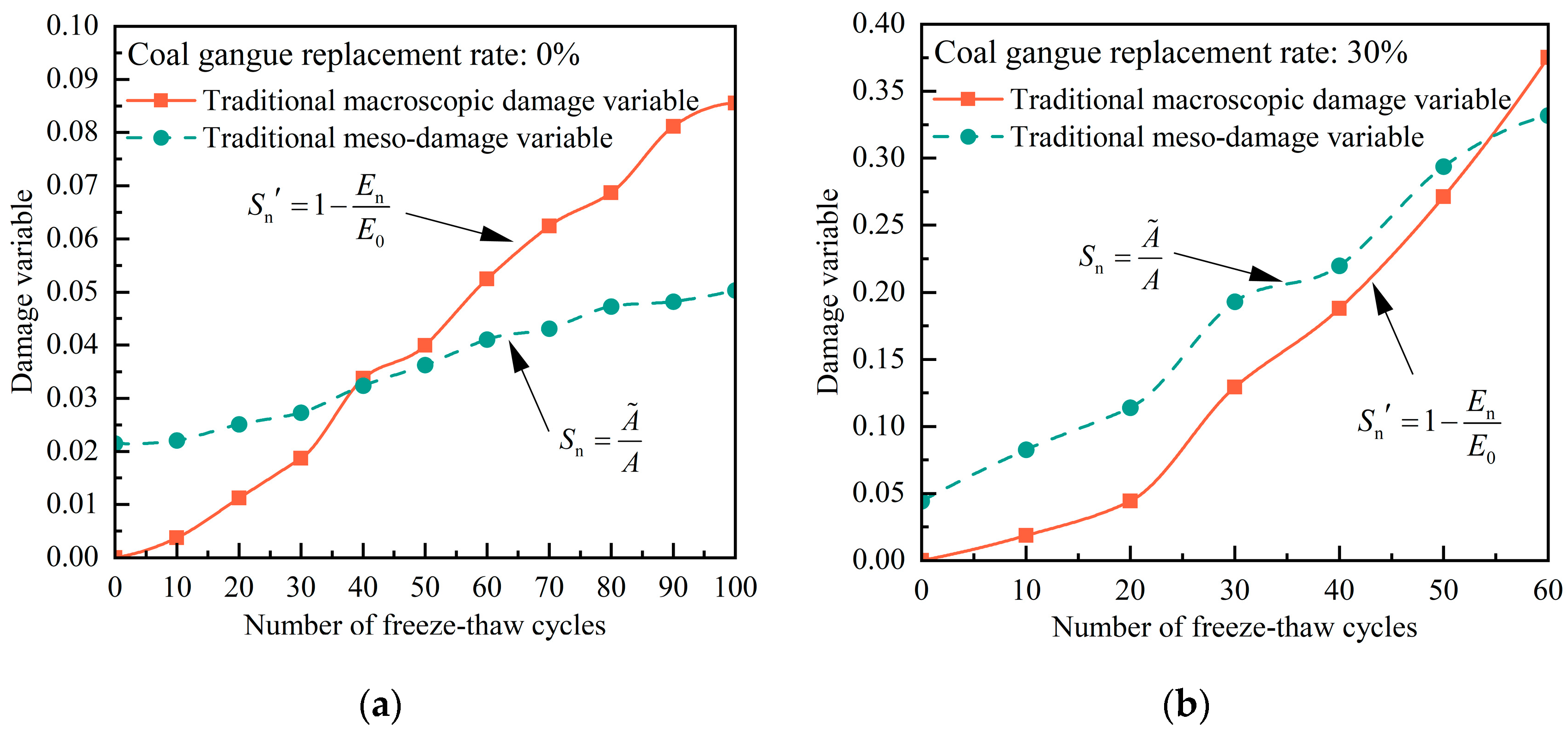

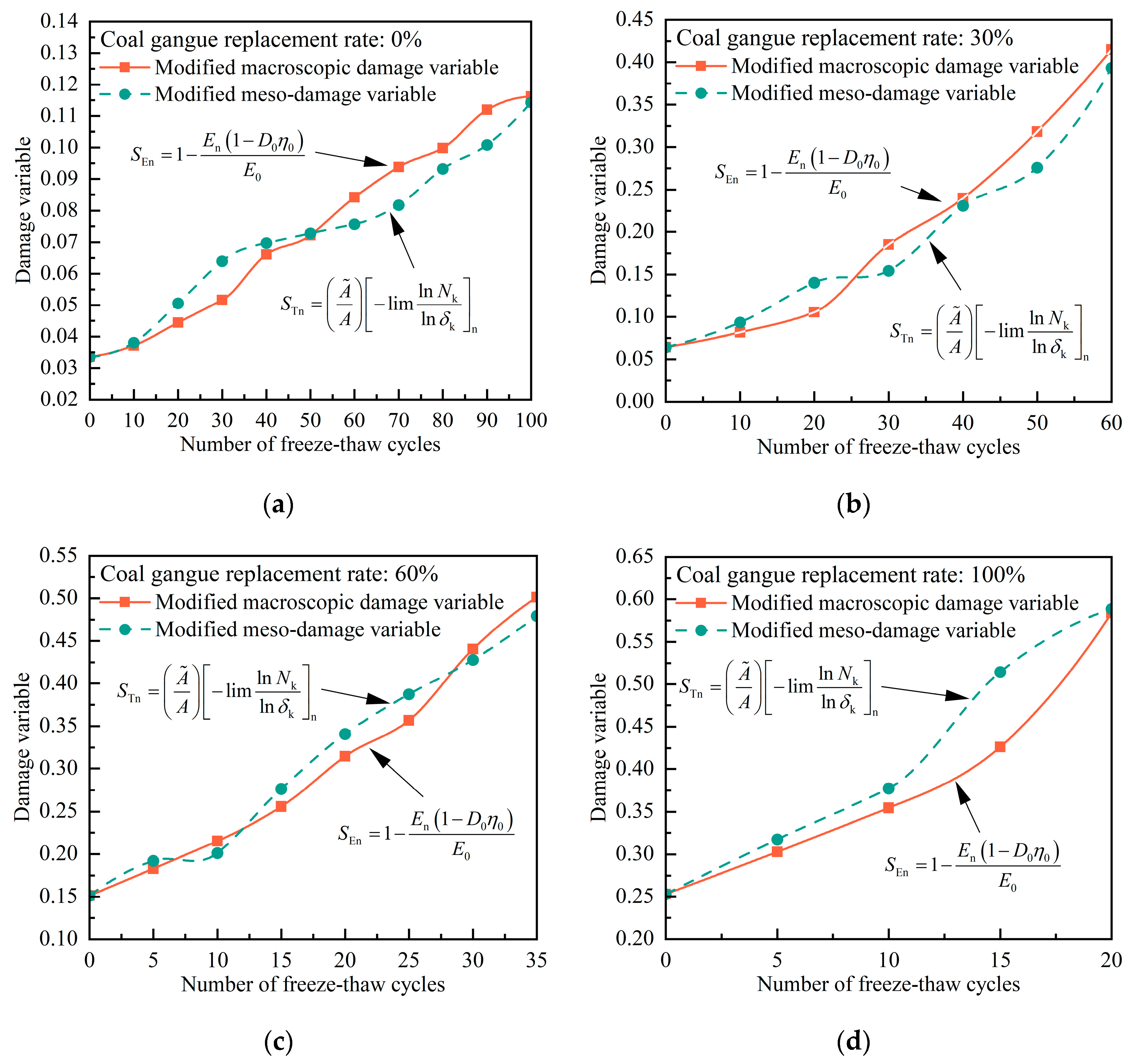

| Classification | Apparent Density (kg/m3) | Packing Density (kg/m3) | Crushing Index (%) | Water Absorption Rate (%) |
|---|---|---|---|---|
| Coal gangue coarse aggregate | 2560 | 1360 | 12 | 5.3 |
| Natural coarse aggregate | 2650 | 1620 | 10 | 0.4 |
| Natural fine aggregate | 2780 | 1430 | - | 0.2 |
| Group | Cement | Water | Natural Aggregate | Coal Gangue Aggregate | Sand | Water Reducer |
|---|---|---|---|---|---|---|
| GC0 | 367 | 165 | 1291 | 0 | 637 | 3.7 |
| GC3 | 367 | 165 | 904 | 374 | 637 | 3.7 |
| GC6 | 367 | 165 | 517 | 748 | 637 | 3.7 |
| GC10 | 367 | 165 | 0 | 1247 | 637 | 3.7 |
| Number of F-Ts | Measured Value of Elastic Modulus [GPa] | Predicted Value of Elasticity Modulus [GPa] | Relative Error |
|---|---|---|---|
| 0 | 3.13 | 3.21 | 2.5% |
| 5 | 3.01 | 3.00 | 0.3% |
| 10 | 2.89 | 2.81 | 2.8% |
| 15 | 2.75 | 2.63 | 4.5% |
| 20 | 2.53 | 2.45 | 3.2% |
| 25 | 2.37 | 2.28 | 3.9% |
| 30 | 2.06 | 2.12 | 2.9% |
| 35 | 1.84 | 1.97 | 6.8% |
Disclaimer/Publisher’s Note: The statements, opinions and data contained in all publications are solely those of the individual author(s) and contributor(s) and not of MDPI and/or the editor(s). MDPI and/or the editor(s) disclaim responsibility for any injury to people or property resulting from any ideas, methods, instructions or products referred to in the content. |
© 2024 by the authors. Licensee MDPI, Basel, Switzerland. This article is an open access article distributed under the terms and conditions of the Creative Commons Attribution (CC BY) license (https://creativecommons.org/licenses/by/4.0/).
Share and Cite
Xin, C.; Yang, Y.; Yang, M.; Di, J.; Sun, Y.; Liang, P.; Wang, Y. Multi-Scale Analysis of the Damage Evolution of Coal Gangue Coarse Aggregate Concrete after Freeze–Thaw Cycle Based on CT Technology. Materials 2024, 17, 975. https://doi.org/10.3390/ma17050975
Xin C, Yang Y, Yang M, Di J, Sun Y, Liang P, Wang Y. Multi-Scale Analysis of the Damage Evolution of Coal Gangue Coarse Aggregate Concrete after Freeze–Thaw Cycle Based on CT Technology. Materials. 2024; 17(5):975. https://doi.org/10.3390/ma17050975
Chicago/Turabian StyleXin, Changhao, Yu Yang, Mengze Yang, Junzhen Di, Yidan Sun, Pengfei Liang, and Yaohong Wang. 2024. "Multi-Scale Analysis of the Damage Evolution of Coal Gangue Coarse Aggregate Concrete after Freeze–Thaw Cycle Based on CT Technology" Materials 17, no. 5: 975. https://doi.org/10.3390/ma17050975
APA StyleXin, C., Yang, Y., Yang, M., Di, J., Sun, Y., Liang, P., & Wang, Y. (2024). Multi-Scale Analysis of the Damage Evolution of Coal Gangue Coarse Aggregate Concrete after Freeze–Thaw Cycle Based on CT Technology. Materials, 17(5), 975. https://doi.org/10.3390/ma17050975





